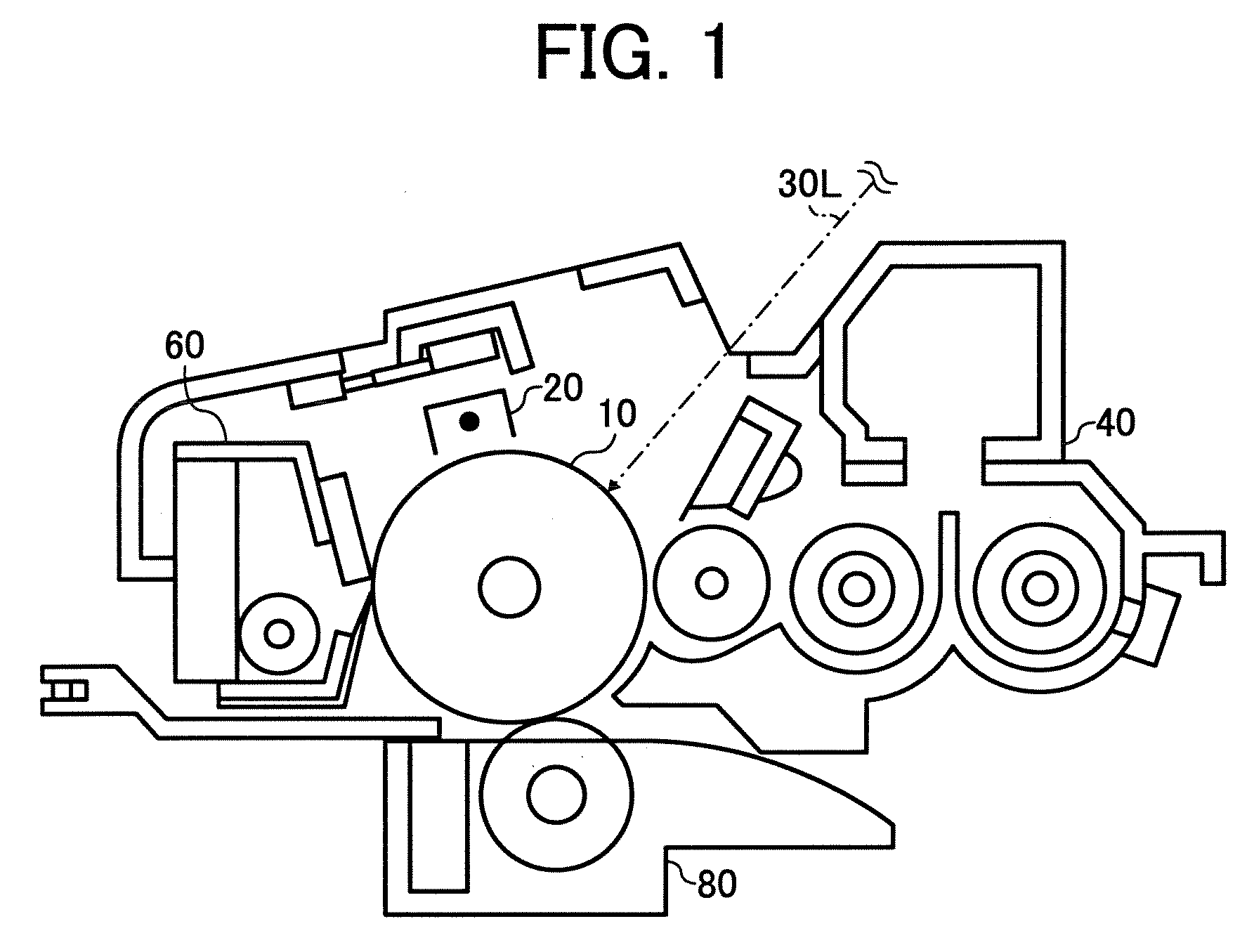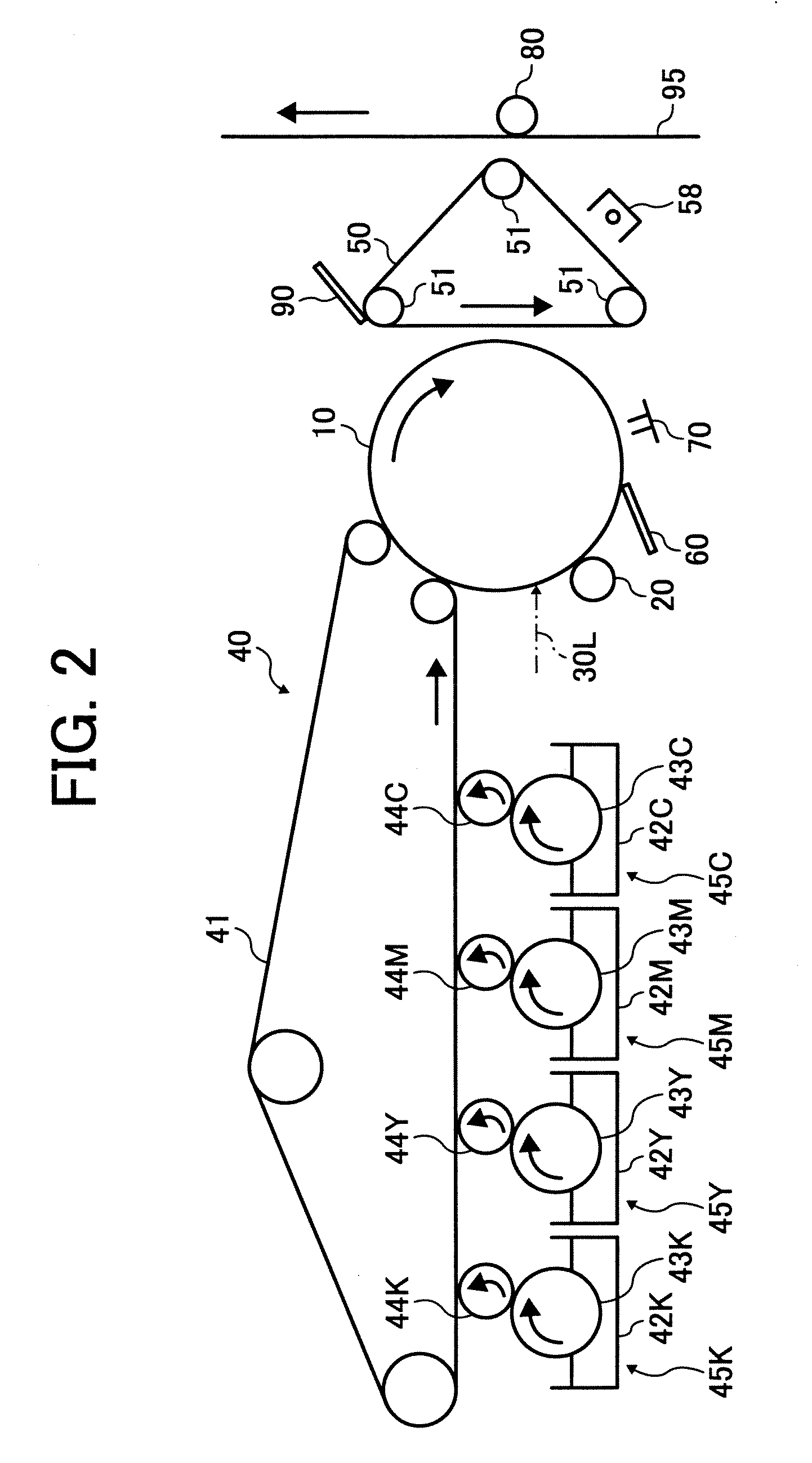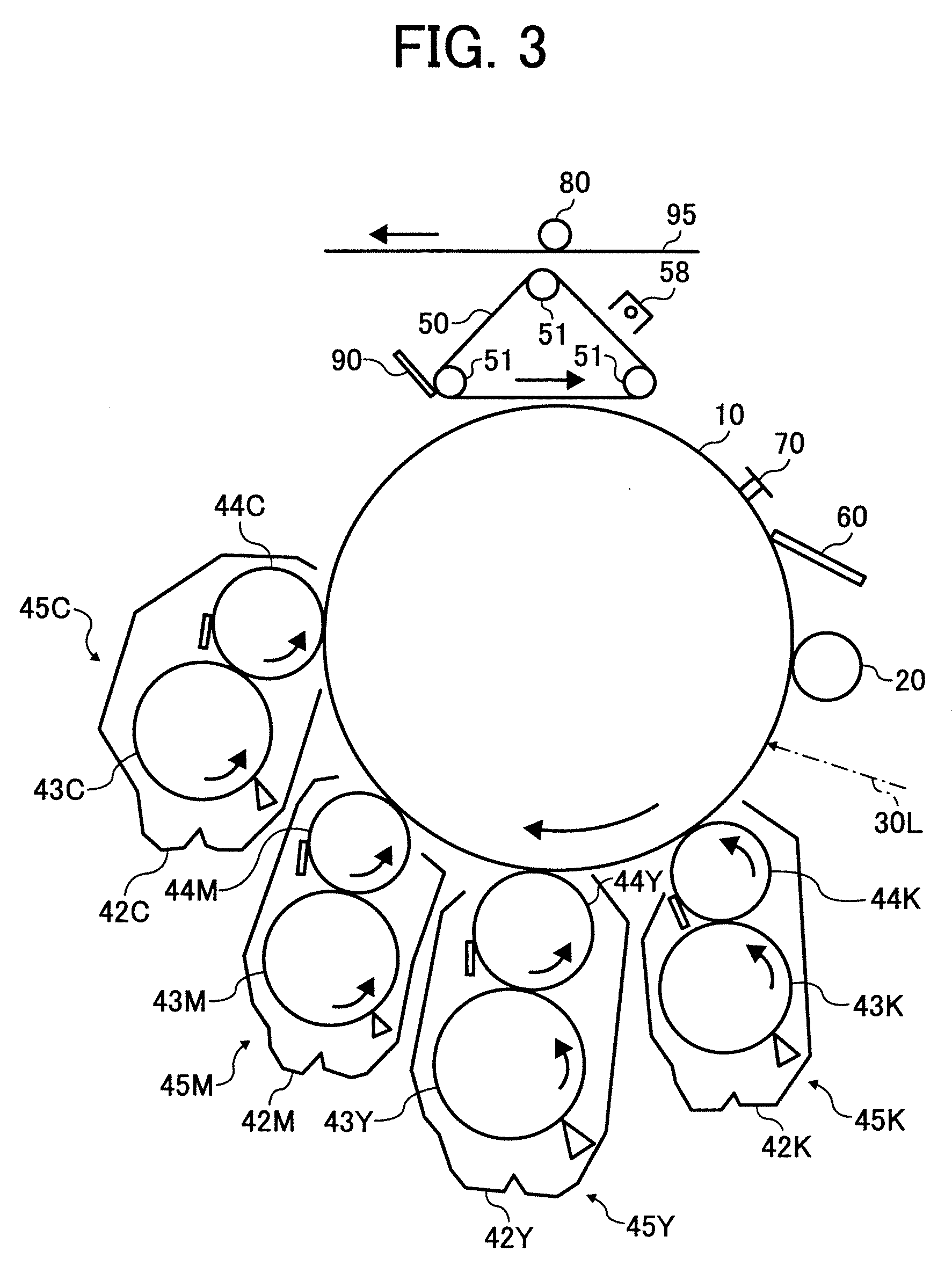[0033]These and other objects, features and advantages of the present invention will become apparent upon consideration of the following description of the preferred embodiments of the present invention taken in conjunction with the accompanying
[0034]FIG. 1 is a
schematic view illustrating an example of the process
cartridge of the present invention;
[0035]FIG. 2 is a
schematic view illustrating an example of the image forming apparatus of the present invention;
[0036]FIG. 3 is a
schematic view illustrating another example of the image forming apparatus of the present invention;
[0037]FIG. 4 is a schematic view illustrating yet another example of the image forming apparatus of the present invention;
[0038]FIG. 5 is a schematic view illustrating an image forming section of the image forming apparatus illustrated in FIG. 4; and
[0040]The method of the present invention for preparing a toner includes the steps of providing toner particles including at least a binder resin; and contacting a
coating fluid including a
silicone resin and at least one of a super critical fluid and a sub-critical fluid with a surface of the toner particles to form thereon a layer including the
silicone resin (this layer is hereinafter referred to as a covering layer). The method for forming a covering layer on toner particles is not particularly limited so long as a fluid in which a
silicone resin is dissolved in a super critical fluid or sub-critical fluid is used.
[0041]Specific examples of the method for forming a covering layer on toner particles are as follows:
[0042](1) A fluid in which a
silicone resin is dissolved in a super critical fluid and / or a sub-critical fluid is coated on the surface of the toner particles by a
spray coating method.
[0043](2) A fluid in which a silicone resin is dissolved in a super critical fluid and / or a sub-critical fluid is mixed with the toner particles under pressure, and then the pressure applied to the mixture is rapidly reduced to expand the fluid. In this case, the silicone resin is precipitated on the
peripheral surface of the toner particles.
[0044](3) A fluid in which a silicone resin is dissolved in a super critical fluid and / or a sub-critical fluid is mixed with the toner particles under pressure, and then at least one of the pressure and the temperature is changed to decrease the
solubility of the silicone resin to the super critical fluid and / or sub-critical fluid. In this case, the silicone resin is precipitated on the
peripheral surface of the toner particles.
[0045]The apparatus for use in forming a covering layer on toner particles is not particularly limited. For example, apparatuses having a pressure-resistant container for preparing a fluid in which a silicone resin is dissolved in a super critical fluid and / or a sub-critical fluid, and a pressure pump for feeding the super critical fluid and / or sub-critical fluid to the container can be used. Specifically, at first a silicone resin is fed into the pressure-resistant container, and then a super critical fluid and / or a sub-critical fluid are fed into the container using the pressure pump to prepare a
coating fluid. The thus prepared coating fluid is contacted with toner particles to form a covering layer on the surface of the toner particles. In this regard,
carbon dioxide is preferably used as the super critical fluid or sub-critical fluid because the fluid becomes a gas when the atmospheric conditions are changed to normal temperature and normal pressure (i.e., 25° C. and one atm.) and therefore it is unnecessary to perform a troublesome
solvent removing operation. In addition, it is unnecessary to perform a washing treatment on the toner particles, resulting in avoidance of waste water and decrease of burdens on the environment.
[0046]The temperature at which a fluid including a silicone resin and a super critical fluid and / or a sub-critical fluid is mixed with toner particles is not particularly limited so long as the super critical fluid and / or sub-critical fluid are present at the temperature, but is preferably from 0 to 100° C. and more preferably from 20 to 80° C. When the temperature is too high, a problem in that the toner particles dissolve in the liquid occurs.
[0047]The pressure at which a liquid including a silicone resin and a super critical fluid and / or a sub-critical fluid is mixed with toner particles is not particularly limited as long as the super critical fluid and / or sub-critical fluid are present at the pressure, and is preferably from 1 to 60 MPa.
[0048]Super critical fluids have intermediate properties between gasses and liquids, and have the following properties:
[0051](3) By changing temperature and / or pressure, the properties thereof such as density,
dielectric constant,
solubility parameter, and free volume can be widely changed;
[0052](4) Since the
surface tension thereof is much lower than those of organic solvents, various materials can be well wetted by the super critical fluid even when the materials have
rough surface.
[0054]Sub-critical fluids are defined as materials which are present as a
high pressure liquid under a temperature / pressure condition in the vicinity of the critical point of the materials. Any known sub-critical fluids can be used for the present invention.
[0054]Sub-critical fluids are defined as materials which are present as a
high pressure liquid under a temperature / pressure condition in the vicinity of the critical point of the materials. Any known sub-critical fluids can be used for the present invention.
[0055]Specific examples of the materials for use as the super critical fluid and sub-critical fluid in the present invention include
carbon monoxide,
carbon dioxide,
ammonia,
nitrogen, water,
methanol,
ethanol, ethane,
propane, 2,3-dimethylbutane,
benzene, chlorotrifluoromethane,
dimethyl ether, etc. Among these materials,
carbon dioxide is preferably used because of having a critical temperature (31° C.) near
room temperature and a critical pressure (7.3 MPa) near normal pressure. Therefore, carbon dioxide can be easily changed to a super critical state. In addition, carbon dioxide is highly safe because of being nonflammable. Further, super critical carbon dioxide achieves a gas state under normal temperature and normal pressure conditions. Therefore, carbon dioxide can be easily collected and reused. Further more, it is not necessary to dry the toner particles treated by a fluid including super critical carbon dioxide, and a waste liquid is not generated. One or more of super critical fluids and sub-critical fluids can be used for the toner preparation method of the present invention.
[0056]The critical temperature and critical pressure are not particularly limited, but the critical temperature is preferably from −273 to 300° C. and more preferably from 0 to 200° C. The critical pressure is preferably as low as possible because the load to toner preparation devices, the costs of toner preparation devices, and the energy used for preparing the toner are low. The critical pressure is preferably from 1 to 100 MPa, and more preferably from 1 to 50 MPa.
[0057]The method of the present invention forms a covering layer on the surface of toner particles utilizing the advantages of super critical fluids and / or sub-critical fluids. Since super critical fluids and sub-critical fluids can be easily separated from the product (i.e., the treated toner particles) and collected, the fluids can be reused. Thus, the method of the present invention is an innovative method which is environmentally-friendly because of using no
solvent such as water and organic solvents.
[0058]In the method of the present invention, another fluid can be added to the super critical fluid and / or sub-critical fluid in order to control the
solubility of the materials constituting the toner particles to the super critical fluid and / or sub-critical fluid. Specific examples thereof include
methane, ethane,
propane,
ethylene, etc.
[0059]In addition, an entrainer (i.e., an azeotropicagent) can be added to the super critical fluid and / or sub-critical fluid to control the solubility of the silicone resin to the fluid. Suitable materials for use as the entrainer include polar organic solvents. Specific examples of the polar organic solvents include
methanol,
ethanol,
propanol,
butanol,
hexane,
toluene,
ethyl acetate,
chloroform,
dichloromethane,
ammonia,
melamine,
urea, thioethylene glycol, etc.
[0060]The entrainer used for the present invention is preferably a poor
solvent for the toner particles and the silicone resin to be used under normal temperature and normal pressure conditions. Namely it is preferable that the toner particles and the silicone resin are insoluble in the entrainer or are slightly swelled by the entrainer. Therefore, the entrainer preferably has a solubility parameter (SP value) different from the solubility parameter of the silicone resin used by 1.0 or more, and preferably 2.0 or more. Specific examples of the materials for use as the entrainer include
methanol,
ethanol and n-
propanol, each of which has a relatively high solubility parameter, and n-
hexane and n-
heptane, each of which has a relatively low solubility parameter. When the solubility parameter difference is too large (for example, 5 or more), the wettability of the fluid including a silicone resin to the toner particles deteriorates, and in addition it becomes impossible to dissolve a silicone resin in a mixture of the entrainer and a super critical fluid and / or a sub-critical fluid.
[0061]The added amount of the entrainer is preferably from 0.1 to 10% by weight, and more preferably from 0.5 to 5% by weight, based on the total amount of the entrainer and the fluid. When the added amount is too small, the effect of the entrainer can be hardly produced. In contrast, when the added amount is too large, a problem in that the mixture cannot achieve a super critical state or a sub-critical state occurs.
[0062]The silicone resin for use in the covering layer of the toner particles is not particularly limited, and any known silicone resins can be used. In addition, any synthesized silicone resins and commercialized silicone resins can be used as the silicone resin. Specific examples of the commercialized strait silicone resins include KR271, KR255, KR152 (which are manufactured by Shin-Etsu Chemical Co., Ltd.), SR2400, SR2406, SR2410, 217, FLAKE RESIN 220, FLAKE RESIN 233, FLAKE RESIN 249, FLAKE RESIN Z-6018, and INTERMEDIATE (which are manufactured by Dow Corning Toray
Silicone Co., Ltd.). Specific examples of the commercialized modified silicone resins include KR206 (
alkyd-modified), KR5208 (acrylic-modified), ES1001N (
epoxy-modified), KR305 (urethane-modified) (which are manufactured by Shin-Etsu Chemical Co., Ltd.), SR2115 (
epoxy-modified), and SR2110 (
alkyd-modified) (which are manufactured by Dow Corning Toray
Silicone Co., Ltd.).
[0063]Among these silicone resins, silicone resins having the following structure are preferably used.
[0064]In the formula, R represents a
hydrogen atom, a hydroxyl group, an alkoxyl group (e.g., a methoxyl group, and an ethoxyl group), an
alkyl group (e.g., a
methyl group, an
ethyl group, and a propyl group) or an
aryl group (e.g., a
phenyl group, a tolyl group and a xylyl group).
[0065]
Silicone resins can be used alone or in combination with another material such as crosslinkable components and charge controlling components.
[0066]The molecular weight of the silicone resin used for the covering layer is not particularly limited, but the weight average molecular weight thereof is preferably from 500 to 100,000 and more preferably from 1,000 to 10,000.
[0010]Toner for use in developing an electrostatic (or magnetic) image is typically a particulate
colored material having a configuration such that a colorant, a charge controlling agent and other additives are included in a binder resin. Methods for preparing such a particulate
colored material are broadly classified into pulverization methods and
polymerization methods.
[0068]When the silicone resin is coated on the surface of the toner particles, it is preferable to crosslink the silicone resin. In order to crosslink the silicone resin, the silicone resin preferably has
silanol groups in an amount of from 0.1 to 10% by weight, more preferably from 0.2 to 9% by weight and even more preferably from 0.3 to 8% by weight, based on the total weight of the silicone resin. When the amount of
silanol groups is too large, problems such that the resultant crosslinked resin film becomes too hard and brittle, and unreacted
silanol groups deteriorate charge stability of the resultant toner to withstand environmental conditions occur. When the silicone resin is crosslinked, any known catalysts for use in crosslinking silanol groups can be used. The amount of silanol groups is determined by the Karl-Fischer
titration method described in JIS K0068 (The method for determining
moisture in chemicals). The abstract of the method is as follows.
 Login to View More
Login to View More 


